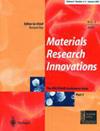Effect of building orientation and fibre type on the mechanical behaviour of additively manufactured ABS matrix composites
Q2 Engineering
引用次数: 0
Abstract
ABSTRACT Additive manufacturing of fibre-reinforced composites show high potential for fabrication of next-generation lightweight complex structural parts. In this study, the effects of building orientation and fibre type, i.e. carbon fibre (CF), and glass fibre (GF), on the mechanical properties of acrylonitrile butadiene styrene (ABS) composites fabricated by fused deposition modelling (FDM) were investigated. The mechanical properties, namely, tensile strength, elastic modulus, hardness, and toughness, were analyzed for flat, on-edge, and upright building orientations. Results revealed that building orientation significantly influences several mechanical properties; in-plane (flat and on-edge) orientations produced the best mechanical properties, whereas upright orientations produced the worst. However, building orientation had little effect on material hardness. Further, compared to the elastic modulus and tensile strength of pure ABS, those of CF-reinforced ABS (CF–ABS) increased by 800% and 500%, respectively, and those of GF-reinforced ABS (GF–ABS) increased by 400% and 400%, respectively, proving that reinforcing ABS with either CF or GF improves the tensile properties. The impact energy of CF–ABS (0.5 J) was lower than that of GF–ABS (1.1 J) because of the brittleness of CF. Fracture surface analysis was performed via scanning electron microscopy (SEM) which gave insight to the nature and mode of fracture of the failed specimens. The most common defects on the printed specimens were void formation, fibre pullout, and poor bonding between fibre and matrix.建筑取向和纤维类型对增材制造ABS基复合材料力学性能的影响
纤维增强复合材料的增材制造在制造下一代轻质复杂结构件方面显示出巨大的潜力。本文研究了碳纤维(CF)和玻璃纤维(GF)的结构取向和纤维类型对熔融沉积建模(FDM)制备的丙烯腈-丁二烯-苯乙烯(ABS)复合材料力学性能的影响。力学性能,即抗拉强度、弹性模量、硬度和韧性,分析了平面、边缘和直立建筑方向。结果表明:建筑朝向对材料的力学性能有显著影响;平面内(平面和边缘)取向的力学性能最好,而垂直取向的力学性能最差。而建筑朝向对材料硬度的影响不大。此外,与纯ABS相比,CF增强ABS (CF - ABS)的弹性模量和抗拉强度分别提高了800%和500%,GF增强ABS (GF - ABS)的弹性模量和抗拉强度分别提高了400%和400%,证明CF和GF增强ABS都能提高ABS的抗拉性能。由于CF的脆性,CF - abs的冲击能(0.5 J)低于GF-ABS的冲击能(1.1 J)。通过扫描电子显微镜(SEM)对破坏试样的断口进行了分析,了解了破坏试样的断裂性质和模式。打印样品上最常见的缺陷是空洞形成、纤维拔出、纤维与基体粘结不良。
本文章由计算机程序翻译,如有差异,请以英文原文为准。
求助全文
约1分钟内获得全文
求助全文
来源期刊

Materials Research Innovations
工程技术-材料科学:综合
CiteScore
5.20
自引率
0.00%
发文量
38
审稿时长
2.8 months
期刊介绍:
Materials Research Innovations covers all areas of materials research with a particular interest in synthesis, processing, and properties from the nanoscale to the microscale to the bulk. Coverage includes all classes of material – ceramics, metals, and polymers; semiconductors and other functional materials; organic and inorganic materials – alone or in combination as composites. Innovation in composition and processing to impart special properties to bulk materials and coatings, and for innovative applications in technology, represents a strong focus. The journal attempts to balance enduring themes of science and engineering with the innovation provided by such areas of research activity.
 求助内容:
求助内容: 应助结果提醒方式:
应助结果提醒方式:


